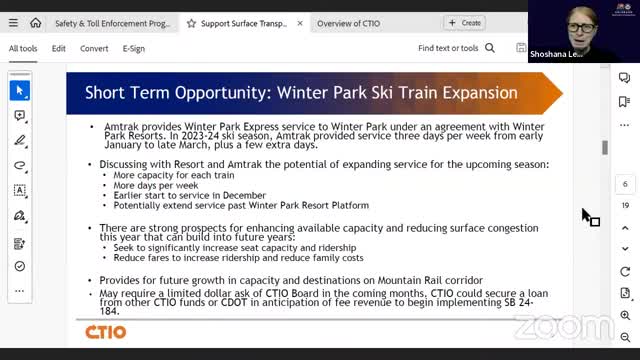Colorado pushes forward with ambitious Front Range rail project
August 14, 2024 | Transportation Commission, Governor's Boards and Commissions, Organizations, Executive, Colorado
This article was created by AI summarizing key points discussed. AI makes mistakes, so for full details and context, please refer to the video of the full meeting. Please report any errors so we can fix them. Report an error »

In a recent government meeting, officials discussed significant advancements in Colorado's transportation infrastructure, particularly focusing on the Front Range passenger rail project and new funding mechanisms to support it. The meeting highlighted the need for immediate financial resources to facilitate incremental improvements in the rail system, emphasizing the importance of collaboration among various state agencies.
Director Liu outlined the ambitious Front Range passenger rail initiative, which aims to connect Fort Collins to Pueblo, with potential extensions to Trinidad. The project will be executed in phases, and a briefing on its planning and development was proposed to ensure all stakeholders are aligned. A key element of the discussion was the establishment of a Joint Powers Authority, which will enable shared governance among agencies involved in the project, including the Front Range passenger rail district and the Colorado Department of Transportation (CDOT).
A notable opportunity for expediting the project was identified through discussions with the U.S. Department of Transportation's Build America Bureau. Officials are seeking to secure a loan for initial safety improvements on the northern alignment of the rail, aiming to finalize this before the end of the Biden administration to avoid delays associated with potential staff turnover during presidential transitions. The proposed improvements include essential safety upgrades that would benefit existing freight operations and could be expedited through a streamlined environmental review process.
Emily Cadaway, the legislative liaison for CDOT, presented details on Senate Bill 184, which aims to create a dedicated funding source for rail and transit projects. The bill introduces a $3 per day fee on rental vehicles, expected to generate approximately $28 million in its first year and $59 million in the following year. This fee is designed to address the congestion and environmental impacts associated with rental cars, which constitute a significant portion of traffic in Colorado.
The legislation aligns with broader state goals of reducing greenhouse gas emissions and enhancing multimodal transportation options. It positions Colorado as a competitive applicant for federal funding, particularly in light of recent legislative changes that have made it easier to access these funds. The meeting underscored the collaborative efforts required to advance these transportation initiatives and the potential for significant improvements in the state's rail infrastructure.
Director Liu outlined the ambitious Front Range passenger rail initiative, which aims to connect Fort Collins to Pueblo, with potential extensions to Trinidad. The project will be executed in phases, and a briefing on its planning and development was proposed to ensure all stakeholders are aligned. A key element of the discussion was the establishment of a Joint Powers Authority, which will enable shared governance among agencies involved in the project, including the Front Range passenger rail district and the Colorado Department of Transportation (CDOT).
A notable opportunity for expediting the project was identified through discussions with the U.S. Department of Transportation's Build America Bureau. Officials are seeking to secure a loan for initial safety improvements on the northern alignment of the rail, aiming to finalize this before the end of the Biden administration to avoid delays associated with potential staff turnover during presidential transitions. The proposed improvements include essential safety upgrades that would benefit existing freight operations and could be expedited through a streamlined environmental review process.
Emily Cadaway, the legislative liaison for CDOT, presented details on Senate Bill 184, which aims to create a dedicated funding source for rail and transit projects. The bill introduces a $3 per day fee on rental vehicles, expected to generate approximately $28 million in its first year and $59 million in the following year. This fee is designed to address the congestion and environmental impacts associated with rental cars, which constitute a significant portion of traffic in Colorado.
The legislation aligns with broader state goals of reducing greenhouse gas emissions and enhancing multimodal transportation options. It positions Colorado as a competitive applicant for federal funding, particularly in light of recent legislative changes that have made it easier to access these funds. The meeting underscored the collaborative efforts required to advance these transportation initiatives and the potential for significant improvements in the state's rail infrastructure.
View full meeting
This article is based on a recent meeting—watch the full video and explore the complete transcript for deeper insights into the discussion.
View full meeting
